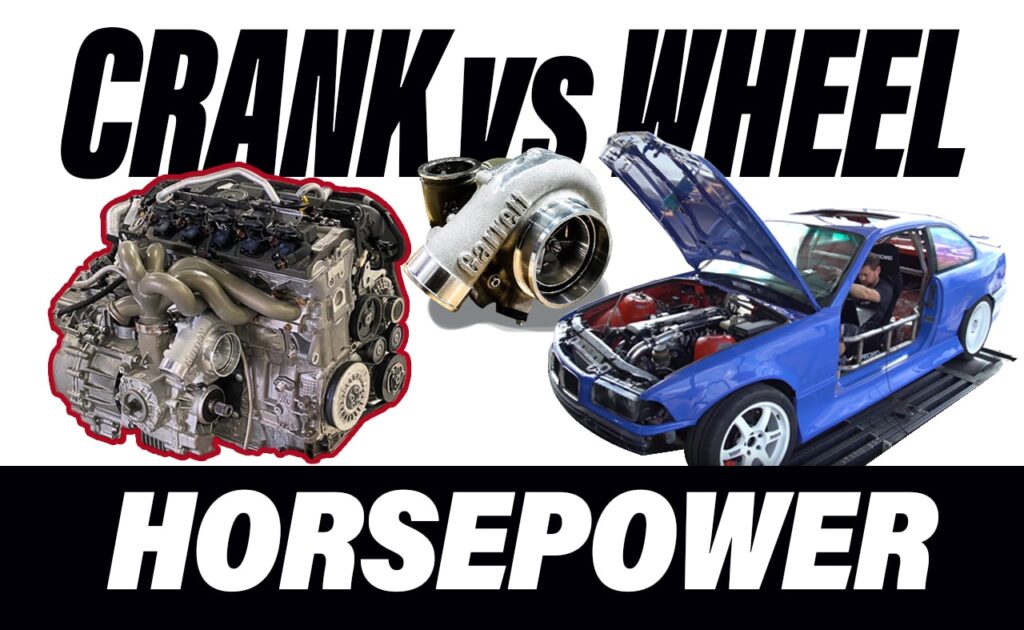How Much Power Is Lost From Crank to Wheels
April 30, 2020
Turbo Tech: Crank Vs Wheel Horsepower And Why It Matters For Your Turbo

Turbochargers are rated for crank horsepower and this article will explain why. A common question and little known fact about turbochargers and horsepower ratings has a lot to do with understanding the difference between crank and wheel horsepower. Crank horsepower or brake horsepower is the power measurement an engine can make without the drivetrain connected. This is the purest way to calculate engine performance and at the same time maybe the least applicable for real world validation. Crank horsepower is also how vehicle manufacturers rate their vehicles. Wheel horsepower is the measurement of power with the drivetrain connected and is performed on a chassis or hub dyno with the engine in the car and all systems running. This is the most common method of measuring horsepower and what most enthusiasts care about. "How much does it make to the wheels?"
Despite what's more popular to claim when building the car of your dreams they both matter when you are selecting a turbo because turbochargers are rated for crank horsepower and you need to know how to calculate for it. The role of a turbocharger is to produce a given amount of air flow at a given pressure ratio to provide the engine with the air it needs to make more power. The rest is up to you and your tuner.
Engine Dyno
This Wegner Motorsports 427 LS7 engine makes 1443 crank horsepower here on the engine dyno. Put that in a rear wheel drive hot rod and it will most likely see 1200 wheel horsepower.
How To Calculate The Correct Target Horsepower
Horsepower at the crank is different than horsepower at the wheels mainly due to parasitic loss. Also known as drivetrain loss, this refers to power lost by the engine from the time it travels through the transmission to the driveline, and through the axles to the wheels. Drivetrain loss varies by transmission type (-10% FWD, -15% RWD, -20% AWD) with the loss being even higher in applications with automatic transmissions. You should consider this before starting your project to avoid disappointment when your car gets hits the dyno. If you are searching for a wheel horsepower target you can use the following recommendations to calculate your target crank horsepower. (FYI, automakers rate a vehicle's horsepower at the crank)
For this example we are going to start with awheel horsepower target of 600 for a rear wheel drive application. In order to find a turbo that can support our target power we need to calculate for the drivetrain loss and multiply 600 x 1.15 = 690 If you want 600 wheel horsepower you need a turbo that can support 690 crank horsepower.
- Front Wheel Drive 10% loss: Wheel Horsepower x 1.1 = Crank Horsepower
- Rear Wheel Drive 15% loss: Wheel Horsepower x 1.15 = Crank Horsepower
- All-Wheel Drive 20% loss: Wheel Horsepower x 1.2 = Crank Horsepower
Conclusion
With drivetrain loss being a complicated and unknown science due to nearly thousands of combinations of parts, properly sizing a turbocharger can save lots of time and headaches at the dyno. For more information on turbo matching please check our free matching program called Boost Adviser.
BOOST ADVISER
How Much Power Is Lost From Crank to Wheels
Source: https://www.garrettmotion.com/news/newsroom/article/turbo-tech-crank-vs-wheel-horsepower-and-why-it-matters-for-your-turbo/